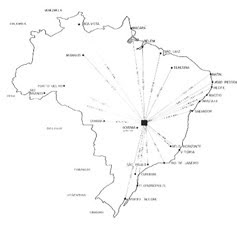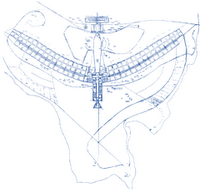The Culmination of Brazilian Modernity
My little tribute to Brasilia's 50 Birthday...
Planted deep in the heart of the central plateau, Brasília has its origins in the early years of the colonial period, when the idea of building a new capital was first suggested:
“The first recorded advocacy of a new capital appeared in 1789 in a statement by a group of political revolutionaries in the state of Minas Gerais, who called themselves ‘inconfidentes mineiros.’ Pioneers in the movement for independence from Portugal, they incorporated in their program the concept of a new governing center, free of the symbolic associations with the colonial regime.” (Evenson, 1973).
In 1821, Bonifácio de Andrada, the patriarch of Brazil’s independence, recommended to the deputies at the Court of Lisbon: “there shall be erected a central town, in the interior of Brazil, as the seat of the court or regency…”. In 1883 an Italian priest known as Dom Bosco had a ‘dream-vision’, in which he saw the ‘promised land’ between the 15th and 20th degrees of latitude, which was regard by many as being a reference to the site of the new capital:
“I saw the bowels of the mountains and the depths of the plains. I had before my eyes the incomparable riches...which would one day be discovered. I saw numerous mines of precious metals and fossil coals, and deposits of oil of such abundance as I had never before been seen in other place. But that was not all. Between the fifteenth and the twentieth degrees of latitude, there was a long and wide stretch of land which arouse at a point where a lake was forming…”
“I saw the bowels of the mountains and the depths of the plains. I had before my eyes the incomparable riches...which would one day be discovered. I saw numerous mines of precious metals and fossil coals, and deposits of oil of such abundance as I had never before been seen in other place. But that was not all. Between the fifteenth and the twentieth degrees of latitude, there was a long and wide stretch of land which arouse at a point where a lake was forming…”
Since these early days, the concept of a capital city planted deep into the Brazilian hinterland became a constant feature of the national debate. The temporary constitution of 1890 came close to admitting the possibility of transferring the capital, but maintained that the issue should be further discussed by the participating states. The final version of this constitution, promulgated in 1891, determined in its 3rd article that: “a territory of 14,400 sq. km, in the central plateau of the Republic, will be surveyed at a convenient time and destined for the establishment of the future Federal Capital.”
The idea had by then taken the form of law, and it would be just a matter of political will to bring it to fruition. Between 1934 and 1953, several governments, both military and democratic, would address the idea of the new capital, but nothing happened until 1956, when president Juscelino Kubitschek (a.k.a. JK) signed the ‘Message of Anápolis’, establishing the location and setting the date for the official transfer of the capital.
Kubitschek was one of the most popular figures to ever occupy the presidential seat in Brazil, and was also a great admirer of the modern architecture, having once worked with Oscar Niemeyer during his term as mayor of the capital of the state of Minas Gerais, during which Niemeyer produced his first notable designs. For Kubitschek, the construction of the new capital was a focus of great national pride and a task to be undertaken with the impetus of pioneers. During one of his visits to the site of the new city, he made the historical remark:
“From this central plateau, from this solitude which will soon be the brain from which will emanate decisions of vital national importance, I look once more to the future of my country and foresee this dawn with unshakable belief and unlimited faith in the greatness of our destiny.”
“From this central plateau, from this solitude which will soon be the brain from which will emanate decisions of vital national importance, I look once more to the future of my country and foresee this dawn with unshakable belief and unlimited faith in the greatness of our destiny.”
In September, 1956, an open national design competition was announced by NOVACAP (Companhia Urbanizadora da Nova Capital), the company chartered with the urbanization of the city. Oscar Niemeyer was later appointed as director on architecture of the company and commissioned with the design of all major governmental buildings.
Twenty-six proposals were presented to the jury, among which were designs by some of the most distinguished architects in Brazil. After narrowing the proposals to ten finalists, the plan devised by Lucio Costa (Fig. 10) was awarded the first prize. Of all submissions, Costa’s was deemed the only one that grasped the notion of a national capital, as stated in the jury’s considerations: “It is the only plan which is for an administrative capital for Brazil. The elements can be seen at once: It is clear, direct and fundamentally simple…” (Evenson, 1973).
The jury felt that the plan succeeded in achieving the much desired monumentality and grandeur within a fairly simple urban structure. One of the jurors also mentioned that “the concept was easy to grasp at a first reading, but had enough depth and a strong sense of unity”.
In his descriptive report, Costa acknowledged that the circumstances required a shift from the conventional urban-thinking and, as such, the character of the city would require more than what mere functionalist urbanism could produce. He argued that:
“It should be conceived, I believe, not as a mere organic entity, able to function effortlessly and vitally like any modern town; not as ‘urbs,’ therefore, but as a ‘civitas,’ having the virtues and attributes appropriate to a true capital city.” (Costa, 1957).
“It should be conceived, I believe, not as a mere organic entity, able to function effortlessly and vitally like any modern town; not as ‘urbs,’ therefore, but as a ‘civitas,’ having the virtues and attributes appropriate to a true capital city.” (Costa, 1957).
Brasilia was officially dedicated on April 21, 1960, after a frantic paced construction process that took three years to complete, from 1957 to 1960. In this sense, Costa’s plan also came in handy for the fulfillment of the government’s framework, which determined that the basic elements of the city should be completed before the end of president Kubitschek’s mandate. The desired sense of monumentality for Brasília was achieved through the use of vast spaces and sleek structures, specially along the monumental area, along which the most important governmental buildings are located.
By comparing Brasília with other similar projects one may realize how impressive this phase of the construction seemed at a time when the scarcity of resources, both technical and material, was tremendous: the American capital Washington DC. took nine years to conclude, India’s New Delhi was completed in eighteen years, and the Australian Canberra was still unfinished after 50 years.
References:
Costa, Lucio. Relatorio do Plano Piloto de Brasilia. Brasilia: DePHA-GDF. 1990.
Evenson, Norma. Two Brazilian Capitals: Architecture and Urbanism in Rio de Janeiro and Brasilia. 1973. New Haven: Yale University Press, 1973.
References:
Costa, Lucio. Relatorio do Plano Piloto de Brasilia. Brasilia: DePHA-GDF. 1990.
Evenson, Norma. Two Brazilian Capitals: Architecture and Urbanism in Rio de Janeiro and Brasilia. 1973. New Haven: Yale University Press, 1973.





Comentários
Postar um comentário